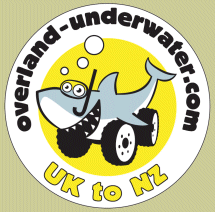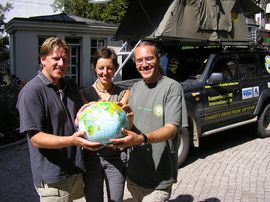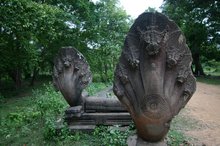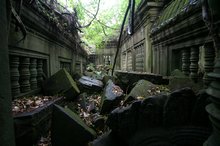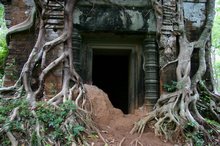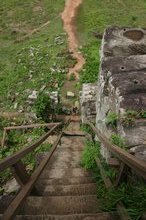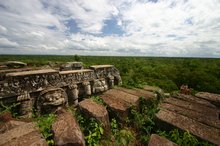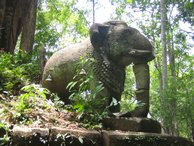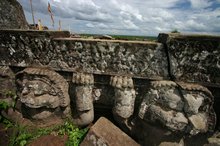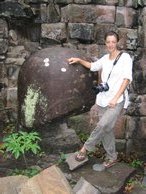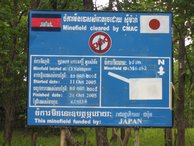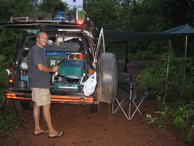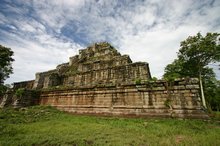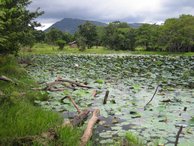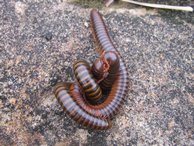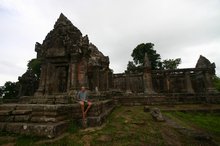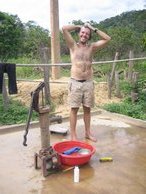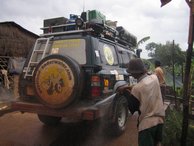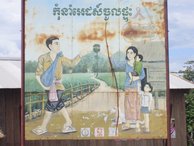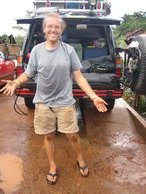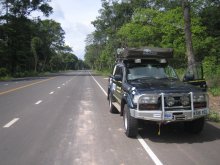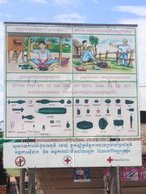| Final Statistics: Alex & Maz | Total distance: 93,550km |
| Furthest Point: Rotorua, NZ | Now settled in Sydney, Australia |
| Final Statistics: Martin | Total distance: 79,698km |
| Furthest Point: Hobart, Australia | Now settled in Bristol, UK |
A temple hunting we will go…
Cambodia, Country 21, Diary entry 20th-24th May 2006, Total distance in Cambodia: 2166 KM
We had made it… Beng Mealea. After a 3 day gruelling offroad trek through the Cambodian jungle we were once again in touristville where we could order a beer and food in the comfort of a road side restaurant. Our first attempt at site seeing was met with a sudden and violent downpour, so we retreated to the shelter of the restaurant and with a can of Angkor in hand a battle of chess commenced.
Fortunately it was just a passing storm and before too long the rain stopped long enough for us to brave a look around the temple. Built in the 12th century under Suryavarman II, Beng Mealea is one of the most mysterious of Angkor temples as nature has well and truly run riot here and standing just a few meters away from the trees it’s hard to tell what lies beneath. Built with the same floor plan as Angkor Wat, spending time to explore this temple playground is the ultimate Indiana Jones experience. You enter from the south and climb over piles of masonry, through dark corridors and between hanging vines before you arrive at the central prang (tower) which has now sadly collapsed.
Having enjoyed our rummage around we needed to decide where to spend the evening and asked some local advice on how the road was to Koh Ker, the next stop on our express tour of Angkorian ruins. Apparently a new privatised dirt road had been carved through the jungle which now put Koh Ker only about 2 hours from Beng Mealea. It sounded worth pushing on and we’d find camp somewhere on route. So after a quick inflate of the tyres back to road spec and a fiddle with one of the valves that kept leaking, we were on our way again.
The road was indeed good with few potholes to slow us down and we were able to make good progress, only pausing for awhile at a toll booth where a supposed $10 was payable, but as no one came – obviously they don’t expect tourist driving at night, we pushed on. With the going good we were soon at Koh Ker and waved at the guy at the gate as we entered. Priority number one was to find camp and soon found a spot just by one of the temples. With it looking like rain again, we had the tent up and were inside playing chess just before the heavens opened!
Before very long the customary sound of someone approaching, this time on a motorbike, had us switching off the light and pretending to be asleep. The mister, MISTER, MISTER grew louder and it was obvious that they weren’t going to leave us in peace. I opened up the side flap and looked down on a guy completely drench standing in the pouring rain. “You no can stay here”… to which we asked why? “I don’t know, but boss says can not stay, must follow us”. I tried explaining that it would be impossible to close up the tent as everything would get drenched, but he was insistent and said it was only 500m away!!
Drastic times call for drastic measures, so with Maz up in the tent handheld radio in hand, I moved the cover as best I could from the windscreen and prepared to follow the motorbike at a slow speed. With the tent up it must have looked a peculiar sight sneaking through the jungle. Of course it wasn’t 500m, more like 3km’s, but at least we were allowed to camp in peace… or almost! It was the place where the temple tourist police were based and one of the chaps had the worlds worst snoring! We could barely concentrate on our chess, so reversed the car as far away as we could before settling down to sleep, ear plugs firmly in place!
In the morning we noticed a couple of ants on the back of the car and on opening the door we’d been infested by hundreds of them, as we must have unknowingly parked on an ant hill in the dark. Every box came out and with a liberal dose of insect spray we seemed to be slowly wining the battle. We talked to the guys and said we’d probably spend one more night if we could tolerate the snoring which they found highly amusing. It was then time to explore the vast former 10th century capital of the Angkorian empire.
Abandoned to the forests, Koh Ker was long one of the most remote and inaccessible temple sites in Cambodia, however with the new toll road you can almost visit from Siam Reap in a daytrip, although it would be a very long day. With no accommodation and limited food stalls, it’s still extremely quite with perhaps 4 or 5 cars visiting a day. We therefore pretty much had the place to ourselves. On exploration the road in from the gate loops around in a P, so no wonder they found us so easily the night before! The temples are scattered along this road and you need transport to go from one to the other.
Also known as Chok Gargyar, Koh Ker was the capital during the reign of Jayavarman IV, who having seized the throne from a rival, left Angkor and moved his capital here, however his son and successor Harshavarman I decided to move back to Angkor! For the short space of its importance however there are a remarkable number of religious buildings in the region, with more than 30 major structures. The area unfortunately was heavily land mined during the Khmer Rouge era and although most of the more significant temples have been cleared, it is still best to err on the side of caution and stick to well worn paths. Work is still actively ongoing to clear the forests and the owner of one restaurant we eat at here told the sad story of a friend who had been killed by a mine.
The principal monument is Prasat Thom, a 40m high sandstone faced pyramid of seven levels. At the top are giant garuda (mythical half-man half-bird creatures) and the view from the summit across the forest spreading in all directions is breathtaking. Within the compound and beyond the inner naga flanked causeway is Prasat Krahon (Red Temple) named after the red bricks used in its construction. Other temples we visited included: Prasat Bram, named in honour of its five prangs, two of which are smothered by strangler figs; Prasat Neang Khmau, with some fine lintels decorating its otherwise bland exterior; Prasat Ke Nov with its impressive elephant and lion statues; and Prasat Leung, which contains one of the largest and best preserved Shiva linga (phallic symbol) seen anywhere in Cambodia.
With a full day of site seeing under our belt we headed out to one of the more remoter temples to cook up dinner and enjoy a bottle of fine red wine which we’d found in a supermarket in Phnom Penh at a bargain price – a superb compliment to our now favourite reminder of home cooked fud – spaghetti bolognaise! We had intended to return to the ‘tranquillity’ of the tourist police to sleep, but just wanted to be alone in the jungle with the mozzies, temples, ants and everything else that took a fancy to us, whilst we eat!
Of course the engine barely has time to get cool, before someone arrives and to cue a family turned up on the back of a moped the father AK47 in hand. We had a regular little chat and he explained that we shouldn’t worry if we heard gun shots through the night; it was just the police and soldiers out hunting for a bit of meat, hopefully of the four legged variety! With the arrival of another scooter, the two took off to leave us in peace to wine and dine – and very nice it was too. True to our word, after dinner we moved back to our appointed camp spot and fortunately the snorer had been re-assigned a different bunk somewhere in the jungle out of ear shot… it must have been very deep, deep in the jungle!
A new day a new temple to head for, this time we were pushing further north to Prasat Preah Vihear. On the border with Thailand and disputed for many years, in 1962 the International Court declared in favour of Cambodia although that was not the end of trouble for the region and as late as 2001-03 the temple was closed to visitors due to a stand off between Thai and Cambodian interests! On the Thai side tourists are herded in the comfort of air-conditioned coaches along a super highway right up to the temple steps, whereas on the Cambodian side the adventure of actually getting there is part of the fun.
We’d read that the journey was a modern day pilgrimage that is almost equal of any undertaken at the height of the Angkorian empire, but in truth, with your own transport, a GPS and the occasional stop for directions, new dirt roads have taken the edge off the adventure. One aspect that still concerned us however was the 600m rollercoaster accent up a 35% gradient of potholes, concrete and loose stones, but we were reassured that with 4 wheel drive engaged Tinfish could make it. The road up was indeed bad and in low ratio had us crawling up to gain traction, but slowly and surely we reached the summit.
And what a truly magical place it is too. Even ignoring the countless tat stalls lining the approach Preah Vihear is a marvel of engineering perched right up to the cliff edge and commanding a spectacular view across the Cambodian plains stretched below as far as the eye can see in all directions – no wonder the Khmer Rouge choose it as their final strong hold, a near impregnable fortress when attached from below. Again mines have needed to be cleared from the temple and it’s surrounds as fighting continued here as recently as 1998 and there are strong warnings everywhere to stay within the cleared areas.
The imposing mountain temple was built by a succession of seven Khmer monarchs, beginning with Yasovarman I and ending with Suryavarman II, the builder of Angkor Wat. It was constructed, like other principal temple mountains from this period to represent Mt Meru and was dedicated to the Hindu deity Shiva. The complex includes five principal gopura (entrance pavilion), which you continue to ascend to, the best preserved being at a higher level. The central sanctuary sits right at the edge of the cliff with its collapsed prang at the centre. It is impressive to walk round the outside and see the foundations literally centimetres from the cliff face.
To sit at the cliff edge and stare across the plains is both a tranquil and surreal experience. The thick forest below looks almost like a sea of grass that you could quite happily jump off the ‘small’ cliff and meander around! It makes you appreciate the dedication of the earlier worshipers who made this trip a pilgrimage from Angkor Thom a mere 140km as the crow flies through dense jungle! Of course the feat of building this cliff top temple is no less spectacular with the huge ‘holy’ stones coming from the ancient Cambodian temple of Wat Phu Champasak in Laos!
We sat at the edge of the cliff, legs dangling and watched the sun set slowly across the plains, whilst sipping the obligatory beer and listening to the local children playing in the ruins. At this height the air was cool and refreshing and it would make a welcome change to the sticky, claustrophobic heat of the jungle below. After a refreshing nights sleep and our time in Cambodia coming to an end. We now faced the equally tricky task of descending the rollercoaster road down the cliff side as unfortunately you are unable to cross the border here by car as you’d have to negotiate the first and longest flight of stairs to the temple, which of course we’d have been willing to have a go at it!
Safely back on the plains we now headed west to the border at the lovely named ‘O Smach!’ We needed to spend just one more night in Cambodia as we had a full 30 days planned in Thailand and they are very strict on people outstaying their 30 day visa, so we needed to plan it down to our day of exit from Thailand to fit in a field visit with CARE that Maz was busy organising. On the drive west we followed long dirt roads in reasonable condition although with the coming rains the roads apparently get mostly washed away. We passed through Anlong Veng which for almost a decade was the ultimate stronghold of the Khmer Rouge and home to Pol Pot, Noun Chea, Khieu Samphan and Ta Mok, the most notorious leaders of Democratic Kampuchea. It only fell to government troops in April 1998 at the same time that Pol Pot mysteriously died.
Having not had a shower for a few days and being out of water, we screeched to a halt when we noticed a well pump amongst a few houses. Planning to fill up, then shower later on, we siphoned water into our tanks then thought what the hell and after asking if it was okay to wash (to which they ran back to the house to kindly get us soap and shampoo!) we had a hair wash and splash down to feel human again. The border was literally just around the corner but it was only mid afternoon and being your typical border town, there didn’t look like an awful lot to interest a passing traveller.
As we killed time with a coke I noticed a car wash. Before long the car was getting a much needed scrub down, inside and out, whilst we supervised from the comfort of a hammock. They did a great job and with time still on our hands and the car on ramps… well at least raised a foot or so, I decide to have ago at repairing the side step that we ripped off along the old Angkor road. It’s amazing what a difference it made not having one, especially for reaching up to prepare the tent, but even simply getting into and out of the car! Of the 8 bolts holding it in place, 7 came off a treat, but of course the final bolt was impossible to reach and reluctant to move. Grit and determination and we had the step riveted and back on in place and me looking like I’d just rolled around in the mud to the amusement of the local crowd gathering!
At least it had killed time and now we needed to find camp. Simple… we just asked at the rather smart petrol station, which even had very clean toilets, but no shower, so we had to pick our time to strip off and shower in the forecourt whilst the other stood guard! They were delighted that we were staying, unfortunately however we seemed to be just outside some kind of housing for the road construction team and all through the night traffic was beeping at the gate to get in and moving to and fro!
After a restless sleep we were at the border and sailed through Cambodian customs and immigration. The only hold up at Thai customs was the crew log that I filled out before wasn’t acceptable, so it needed doing again for this border and also the chap wasn’t 100% sure what to do with the carnet. After reading every tab in Arabic, Urdu, Turkish etc he seemed to get the idea and with a helping point of the finger from me we got stamped in, plus another red stamp that looked pretty good too, just to be sure! Welcome back to Thailand.
From the dirt potholed roads of Cambodia we were once again on the ultra smooth highways of Thailand. With the border far behind us, from the corner of our vision we caught sight of a red concrete pole just off the road. Only then we realised what a charged atmosphere it had been during our time in Cambodia, for there it would have meant mines, here it probably just marked an underground electricity cable or the like!
The legacy of land mines in Cambodia is the worst anywhere in the world, with an estimated four to six million dotted about the countryside. As many as 40,000 Cambodians have lost limbs due to mines which translates to about one in 275 people. They remain one of Cambodia’s top killers and litter the country. Buried in rice-fields and on roadsides, even after extensive mine awareness campaigns, they still claim 25 to 35 victims a month. This is a vast improvement on a decade ago, when the figure was more like 300, but still entirely unacceptable for a country officially at peace. To make matters more complicated, areas that appear safe in the dry season become unsafe in the wet season as the earth softens.
The cost to an extensively mined country is enormous. In a developing country like Cambodia, the UN estimates that the lifetime rehabilitation of a land mine victim costs US$3000. With 40,000 the cost is around US$120 million! There are a number of groups actively working in Cambodia to alleviate the problem of mines. The Cambodian Mine Action Centre (CMAC) is an all Cambodian government agency operating with technical support from overseas governments. Hazardous Areas Life (Support) Organisation (HALO Trust) was one of the pioneers of mine clearing in Cambodia. The Mine Advisory Group (MAG) is a British outfit that trains Cambodians in mine clearance. It has launched programmes to train mine victims and all women teams in mine clearance. It has also pioneered mine awareness programmes throughout the country involving puppet shows for children and posters in rural communes.
There have been some breakthroughs in the campaign to ban land mines in recent years. In 1997 more than 100 countries signed a treaty banning the production, stockpiling, sale and use of land mines. Some important international players in land mine production signed the treaty, including Italy, France and the UK. However, the world’s major producers, including China, Russia and the USA refuse to sign, so even as you read this land mines continue to be produced. Cambodia was a signatory to the treat and while it is commendable that it has signed, the treat does little to alleviate the everyday nightmare of life in heavily mined rural provinces. Mine clearing in Cambodia is tragically too often a step-by-step process. For the majority of Cambodians the underground war goes on. You can learn more about landmines at the International Campaign to Ban Landmines website.
| All content copyright © overland-underwater.com - please do not use without permission. |
